
For the first time ever, scientists in Antarctica attached a camera to a minke whale and captured incredible evidence of how it feeds. The camera – one of three “whale cams” funded by WWF-Australia – is part of efforts by scientists to better protect whale feeding areas in Antarctica.
The camera was secured to the whale’s body using non-invasive suction cups that are designed to fall off after 24-48 hours. In an incredible stroke of luck, the camera slid down the side of the whale but stayed attached. The resulting footage—which would not have been possible with the original camera placement—shows how the whale’s throat expands as it moves through the water and feeds.
Minke whales grow to about 29 feet and are the second smallest baleen whale. They filter primarily krill or small fish out of the water using specialized feeding plates, known as baleen, in a method known as lunge feeding.
“What was remarkable was the frequency of the lunges and how quickly they could process water and feed again, repeating the task about every 10 seconds on a feeding dive,” said Dr. Ari Friedlaender, an associate professor from the University of California Santa Cruz and lead scientist on the research. “He was like a Pac-Man continuously feeding.”
Sea ice is an important part of a minke’s habitat, a place where they feed and hide from killer whales. The minke’s ability to maneuver through sea ice, due to its relatively small size, and its skill in feeding quickly has helped the whale survive in the Antarctic. But because of climate change, sea ice in the Antarctic Peninsula is shrinking.
There is also concern that critical feeding areas for baleen whales – and other krill predators such as penguins, seals and seabirds – overlap with the krill fishery industry.
“WWF is working with Dr. Friedlaender and his team to put his vital new information about whales before decision makers,” said Chris Johnson, senior manager of WWF’s Antarctic Program, who joined Dr. Friedlaender on the trip as part of the research team.
WWF-Australia has provided funding for three ‘whale cams’ to help scientists better understand critical feeding areas in the Southern Ocean and the impact of shrinking ice caused by warming sea temperatures. WWF is advocating for more marine protected areas in Antarctica to protect its remarkable biodiversity.
Dr. Ari Friedlaender’s work is supported by OneOcean Expeditions and is in collaboration with scientists from Stanford University and the California Ocean Alliance. It is conducted under permits granted from the National Marine Fisheries Service and Antarctic Conservation Act, including institutional animal care and use protocols.
The research is being conducted in collaboration with scientists at the Australian Antarctic Division in Hobart and under the auspices of the International Whaling Commission’s Southern Ocean Research Partnership (IWC-SORP). The aim of the Partnership is to implement and promote non-lethal whale research techniques to maximize conservation outcomes for Southern Ocean whales.
Published February 20, 2018 at 06:00AM
No comments:
Post a Comment